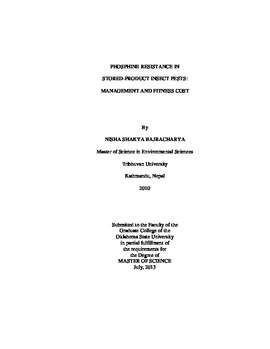| dc.contributor.advisor | Opit, George P. | |
| dc.contributor.author | Bajracharya, Nisha Shakya | |
| dc.date.accessioned | 2014-09-24T14:18:25Z | |
| dc.date.available | 2014-09-24T14:18:25Z | |
| dc.date.issued | 2013-07-01 | |
| dc.identifier.uri | https://hdl.handle.net/11244/11143 | |
| dc.description.abstract | Highly phosphine-resistant populations of Rhyzopertha dominica (F.) (Coleoptera: Bostrichidae) and Tribolium castaneum (Herbst) (Coleoptera: Tenebrionidae) have recently been found in Oklahoma grain storage facilities. These findings necessitate development of a phosphine resistance management strategy for continued effective use of phosphine. Therefore, this study investigated the efficacies of two grain insecticides, namely, spinosad and chlorpyrifos-methyl + deltamethrin against highly phosphine-resistant R. dominica and T. castaneum. Observations showed that both spinosad and chlorpyrifos-methyl + deltamethrin caused 83-100% mortality in resistant R. dominica and caused total progeny production suppression for all post-treatment storage periods: 2, 84, 168, 252, and 336 d. However, in resistant T. castaneum, the highest mortality caused by spinosad was only 3% for all storage periods. Chlorpyrifos-methyl + deltamethrin was effective against resistant T. castaneum only in treated wheat stored for 2 and 84 d where it caused 93-99% mortality. However, chlorpyrifos-methyl + deltamethrin achieved total suppression of progeny production in T. castaneum at all storage periods. Spinosad was not as effective as chlorpyrifos-methyl + deltamethrin at suppressing progeny production of resistant T. castaneum. Experiments were also conducted to measure population growth and developmental rates of phosphine-resistant and -susceptible populations in a phosphine-free environment in order to assess the fitness effects caused by phosphine resistance in these two species. Three resistant R. dominica populations tested exhibited lower population growth and developmental rates than the susceptible population indicating fitness cost in resistant insects. However, the only resistant T. castaneum population tested exhibited a higher population growth and developmental rates than the susceptible population indicating fitness benefit in resistant insects. This means phosphine resistance development in R. dominica populations where resistance has not developed can be slowed by infrequent use of phosphine, whereas it can be mitigated by suspending phosphine use for extended periods of time in resistant populations. However, the same is not true for T. castaneum. For both scenarios, the most appropriate option is to eliminate the resistant individuals, for example, by using spinosad or chlorpyrifos-methyl + deltamethrin. These two insecticides can be used in a phosphine resistance management strategy for R. dominica and T. castaneum in the U.S. | |
| dc.format | application/pdf | |
| dc.language | en_US | |
| dc.publisher | Oklahoma State University | |
| dc.rights | Copyright is held by the author who has granted the Oklahoma State University Library the non-exclusive right to share this material in its institutional repository. Contact Digital Library Services at lib-dls@okstate.edu or 405-744-9161 for the permission policy on the use, reproduction or distribution of this material. | |
| dc.title | Phosphine Resistance in Stored-Product Insect Pests : Management and Fitness Cost | |
| dc.type | text | |
| dc.contributor.committeeMember | Talley, Justin | |
| dc.contributor.committeeMember | Jones, Carol L. | |
| osu.filename | Bajracharya_okstate_0664M_12952.pdf | |
| osu.accesstype | Open Access | |
| dc.description.department | Entomology | |
| dc.type.genre | Thesis | |
